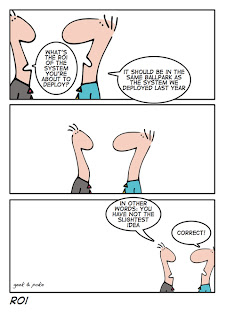Investing in a New HCM System? Determine the True ROI
The following post first appeared in 2018.
When you make the decision to install a new HRIS system, you may or may not factor-in a potential return on investment (ROI). Some systems are necessary regardless of cost (i.e., Payroll), while others (talent management, for instance) may require some level of financial justification.
Some systems, however, clearly demonstrate a solid ROI. One obvious example is replacing a manual time and attendance collection process with an automated one. Automated T&A systems dramatically reduce time collection and processing hours (thereby reducing FTEs), and reduce errors to almost 0%. Not to mention stricter adherence to payroll policies.
Example:
Take a look at the following example:
- 500 employee company with an average $45,000 annual salary = $22,500,000 annual payroll
- According to the American Payroll Association automating T&A can save a minimum of 1% of payroll = $225,000 annual savings
- A typical SaaS-based Time &Attendance system (clocks, software, services, etc.) for a 500 employee firm will generally cost <$100,000 annually for a top-name system
- That amounts to a virtually instant ROI ($100K annual investment to save $225K annual payroll expense)
One caveat is the inclusion of hard dollar savings (i.e., less paper used) vs. soft dollar savings (i.e., FTE time). Why aren’t FTE savings a hard dollar benefit? Because payroll departments rarely cut headcounts, even if they can. More often than not, underutilized FTE resources are reallocated to other responsibilities. But the overall benefits are still obvious.
Other systems, such as HR Help Desk, can demonstrate a solid ROI as well, though not as directly. A comprehensive help desk includes employee self-service features such as a FAQ database and real-time case history. In actual practice self-service features reduce unnecessary calls into HR, freeing up FTE time. However, ROI benefits from HR Help Desk systems are primarily based on soft dollar savings — greater employee satisfaction and engagement, greater adherence to HR policies, and workforce analytics, for example.
In addition to saving Human Resources FTE time, HR Help Desks can save considerable workforce time since fewer workday hours are spent by employees looking for a resolution to their HR issues and requests. Can that actually be quantified, with a dollar value placed on it? Possibly, but in reality management understands that the intrinsic benefits generally outweigh possible financial gains. Hard dollar ROI is rarely the reason or motivator in selecting many HR systems, such as Talent Management and Help Desk. Unfortunately HR is often tasked (by the finance department) with demonstrating at least marginal cost savings, even when that is not the point of the investment. This is where soft dollar benefits must be articulated and emphasized.
If you are required to conduct an ROI analysis when evaluating new systems, the chart below will provide some guidance:
| Hard Dollars | Soft Dollars |
|---|---|
| Office Supplies | FTE time (if resources are reallocated) |
| Overhead expenses | Workforce time |
| Third party vendor expenses | Employee / customer satisfaction |
| FTE time (if reducing is a goal/mandate) | General increase in productivity |
| IT expenses | Less workforce turnover |
| Reducing $$ errors (i.e., paycheck errors) | Improved adherence to policies and regulations |
| Other quantifiable expenses | Reduced risk of legal action against the company |
If your organization requires an RFP selection process, include questions about ROI. No one will know better than your vendors how to sell the investment cost to senior management (and especially the finance people). Take the best responses from each vendor and you will have the ammunition needed to “sell” the investment.
Remember, hard dollar savings are obvious but often not enough of a decision factor. Balanced with sufficient soft dollar benefits, you are well on the way to your new system.








I appreciate your work on ROI. It’s great information. Thanks for sharing such a wonderful read on ROI information. Keep sharing such kind of worthy information.
Informative blog, Thank you for sharing.